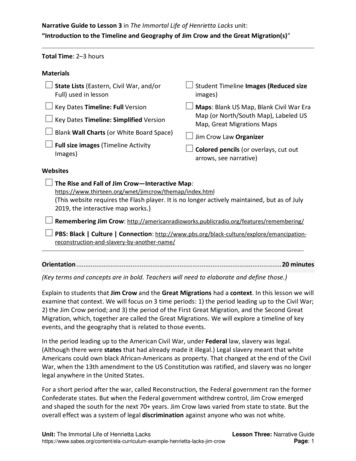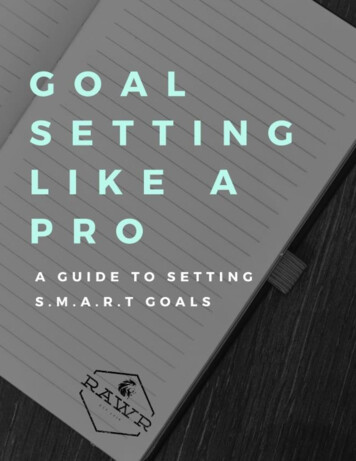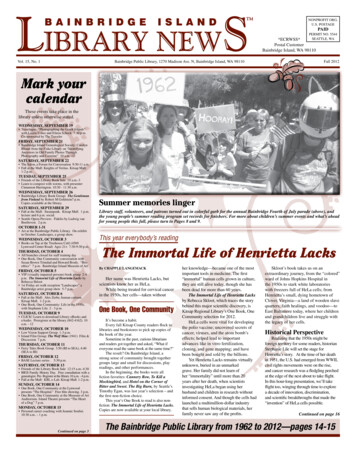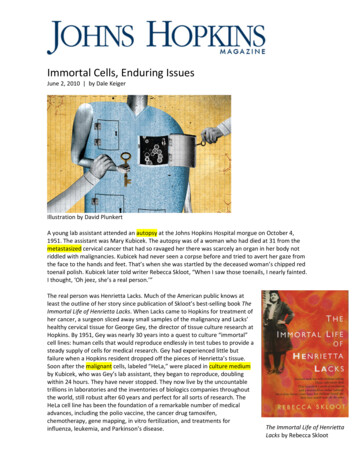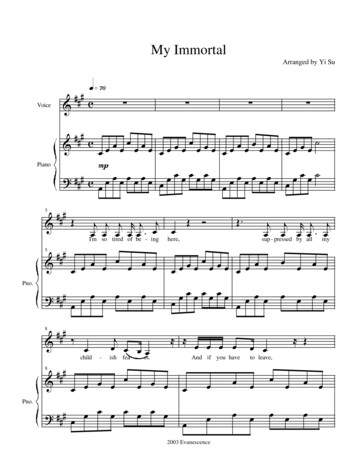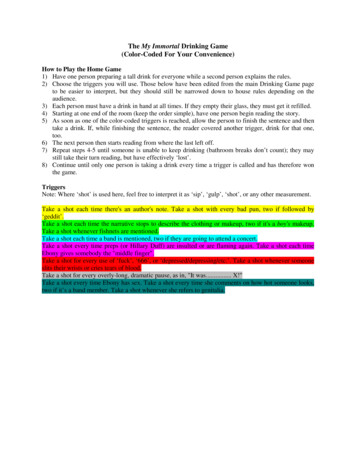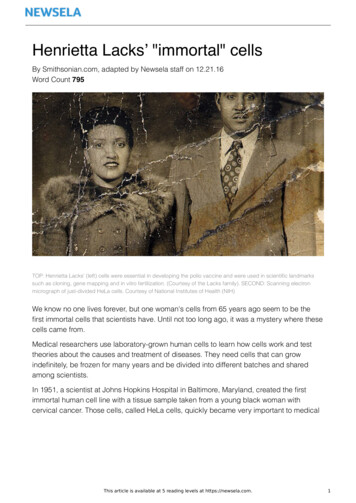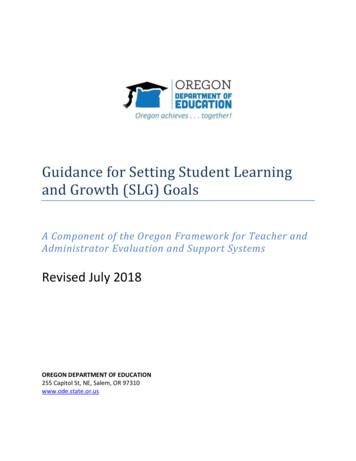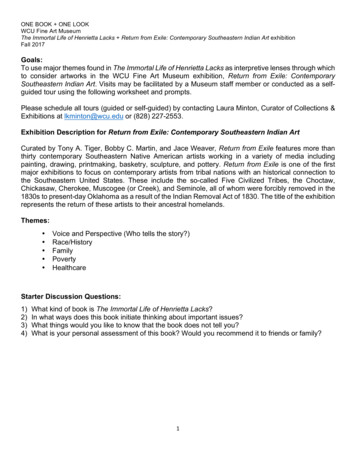
Transcription
ONE BOOK ONE LOOKWCU Fine Art MuseumThe Immortal Life of Henrietta Lacks Return from Exile: Contemporary Southeastern Indian Art exhibitionFall 2017Goals:To use major themes found in The Immortal Life of Henrietta Lacks as interpretive lenses through whichto consider artworks in the WCU Fine Art Museum exhibition, Return from Exile: ContemporarySoutheastern Indian Art. Visits may be facilitated by a Museum staff member or conducted as a selfguided tour using the following worksheet and prompts.Please schedule all tours (guided or self-guided) by contacting Laura Minton, Curator of Collections &Exhibitions at lkminton@wcu.edu or (828) 227-2553.Exhibition Description for Return from Exile: Contemporary Southeastern Indian ArtCurated by Tony A. Tiger, Bobby C. Martin, and Jace Weaver, Return from Exile features more thanthirty contemporary Southeastern Native American artists working in a variety of media includingpainting, drawing, printmaking, basketry, sculpture, and pottery. Return from Exile is one of the firstmajor exhibitions to focus on contemporary artists from tribal nations with an historical connection tothe Southeastern United States. These include the so-called Five Civilized Tribes, the Choctaw,Chickasaw, Cherokee, Muscogee (or Creek), and Seminole, all of whom were forcibly removed in the1830s to present-day Oklahoma as a result of the Indian Removal Act of 1830. The title of the exhibitionrepresents the return of these artists to their ancestral homelands.Themes: Voice and Perspective (Who tells the story?)Race/HistoryFamilyPovertyHealthcareStarter Discussion Questions:1)2)3)4)What kind of book is The Immortal Life of Henrietta Lacks?In what ways does this book initiate thinking about important issues?What things would you like to know that the book does not tell you?What is your personal assessment of this book? Would you recommend it to friends or family?1
Theme 1: Voice & Perspective (Who tells the story?)ONE LOOK: Return from ExileIn her essay for the Return from Exile exhibition catalogue, native scholar Dr. Mary Jo Watson beginswith a quote taken from a 1976 book titled The Southeastern Indians. The quote reads, “All peopleshave blind spots in their memories of the past, but the Southeastern Indians are the victims of a virtualamnesia in our historical consciousness.” Dr. Watson continues, “These words written some forty yearsago remain pervasive in many areas of American history and art history. To correct this ‘blind spot’, agroup of Southeastern Indian artists are now reclaiming their cultural heritage and artistichistories This special exhibition, Return from Exile: Cotemporary Southeastern Indian Art, makes abold statement. We are here! We live and remember.” What does this quote tell you about the exhibition and the artists included in it?Why is it significant to know that this exhibition was curated by native artists and the catalogueessays written by native scholars?What perspectives do you expect to encounter through the works in this exhibition?ONE BOOK: The Immortal Life of Henrietta LacksPerspective also plays a role in The Immortal Life of Henrietta Lacks. Please read the followingquote and discuss the questions below.“I’ve done my best to capture the language with which each person spoke and wrote: dialogue appearsin native dialects; passages from diaries and other personal writings are quoted exactly as written. Asone of Henrietta’s relatives said to me, “If you pretty up how people spoke and change the things theysaid, that’s dishonest. It’s taking away their lives, their experiences, and their selves” (Skloot, xiii). In your opinion, author Rebecca Skloot successful in her aim to accurately represent the Lacksfamily and their stories?Who are the characters in The Immortal Life of Henrietta Lacks?Whose perspectives are represented in the book?Why is it important to represent multiple voices?2
Theme 2: Race/HistoryONE LOOK: Return from ExileLook closely at the drawing Yesterday, Today and Tomorrow by Eastern Band Cherokee artistFaren Sanders Crews.Here, Crews depicts the Cherokee’s Green Corn Ceremony, which was traditionally held when the cornwas ripe. The ceremony was held annually after the removal in the 1830s and through 1914. After this,it is unclear if the ceremony was practiced or how often for most of the twentieth century as manytraditions and languages were lost. The dance was revived in 1988 and is still practiced today.In the artist’s own words about the Green Corn Ceremony, “Yesterday, Today, and Tomorrow, is mytriptych depiction. We endeavor to persevere, we remain, we survive, we are here, we are the same—we are a living culture. Our arts and traditions define us. We endure—we are Tsa-la-gi—a strong, greatand proud race.” What does the title of this artwork mean to you?What are the differences and similarities you perceive between the three panels?How does the artist write about and depict both traditional and contemporary Cherokee culture?ONE BOOK: The Immortal Life of Henrietta LacksIn The Immortal Life of Henrietta Lacks, Deborah states, “Like I’m always telling my brothers, ifyou gonna go into history, you can’t do it with a hate attitude. You got to remember, times wasdifferent”(Skloot, 276). What does she mean by this statement?How are race and history crucial to the story of Henrietta Lacks and her family?3
Theme 3: FamilyONE BOOK: The Immortal Life of Henrietta LacksAt the beginning of the book, Rebecca Skloot writes, “I’ve spent years staring at photo,wondering what kind of life she led, what happened to her children, and what she’d think aboutcells from her cervix living on forever – bought, sold, packaged, and shipped by the trillions tolaboratories around the world” (Skloot, 1). Have you ever looked at a photograph and wanted to know more about the person depicted in it?o What did the photograph look like and who was in it?Do you have old photographs of your family? Friends? Self? What do you think about or rememberwhen you see these?ONE LOOK: Return from ExileNow look at the artwork by Bobby C. Martin (Muscogee Creek), Uncle DavidKilled in Action, 1944. What is the historical context for this work?Do you recognize the brand name seen behind the figure?What does this painting say to you about remembering the past?How might you connect ideas behind this painting to those found in TheImmortal Life of Henrietta Lacks?Next, consider the sculpture by Bobby C. Martin (Muscogee Creek) and Tony A. Tiger(Creek/Seminole/Sac & Fox), Mekusape Fullvnna: Muscogee Gravehouse.This title of this piece is taken from a Muscogee hymn typicallysung in church, commonly at funerals. The song is about howa person lived a life of Christian faith. The sculpture is a similarconstruction to that of a Muscogee gravehouse, built over thegrave of a deceased loved one to mourn that individual. Thestructure is not disturbed after it is built and slowly falls apartduring the course of the remaining mourners’ lifetimes. It is thendismantled by the next generation.The artists write “Our thoughts for creating the piece allowed usto remember and honor our ancestors who were removed fromancestral homelands from the Southeast and Northeast to Indian Territory: our ancestors wereMuscogee Creek, Seminole and Sac & Fox. All three tribes had their own Trail of Tears. Thegravehouse is not a mournful remembrance, it is a thoughtful reminder that we are more than justphysical beings, we are soul and spirit as well.” Who do you think is depicted on the roof of the gravehouse?How does this artwork incorporate religion?How do the artists represent their past and present?Do you find this work to be meaningful?4
ONE BOOK: The Immortal Life of Henrietta LacksCompare what you now know of this artwork to Henrietta’s funeral scene in the book.“The Lacks cousins don’t remember much abut the service—they figure there were some words,probably a song or two. But they all remember what happened next. As Cliff and Fred loweredHenrietta’s coffin into her grave and began covering her with handfuls of dirt, the sky turned black asstrap molasses Years later, when Henrietta’s cousin Peter looked back on that day, he just shook hisbald head and laughed: ‘Hennie never was what you’d call a beatin-around-the-bush woman,” he said.’‘We shoulda knew she was tryin to tell us somthin with that storm’” (Skloot, 92). How are funerals and death portrayed in the artwork and the book?What is the importance of memory to the artists and the characters in the book?5
Theme 4: PovertyONE LOOK: Return from ExileExamine Mel Cornshucker’s work titled Oklahoma: We’re OK.The artist writes, “Georgia, Alabama, Eastern Tennessee, andWestern North Carolina—these lands were ours to own. Weraised our families and thrived as a People and a Nation. Thencame the removal. Our lives were changed forever. When theforced march finally ended, we were confined by thegovernment to lands not of our choosing. We were confined byinvisible boundaries—depicted in Oklahoma—We’re OK by thesteel frame—to lands deemed useless. And here we remained.But, as is our nature, we took an adversity and made the mostof our lives, in spite of the hardship forced upon us.” What is the artist depicting in this work?What do you notice about all of the structures?What is the significance of the shape and way in which the teepees are placed?What is the significance of the title of this work?How does this work demonstrate resilience?ONE BOOK: The Immortal Life of Henrietta LacksNow, recall the descriptions provided by Rebecca Skloot of Lacks Town and Clover when shetravels there to speak with Henrietta’s relatives.“The dividing line between Lacks Town and the rest of Clover was stark. On one side of the two-laneroad from downtown, there were vast, well-manicured rolling hills, acres and acres of wide-openproperty with horses, a small pond, a well-kept house set back from the road, a minivan, and a whitepicket fence. Directly across the street stood a small one-room shack about seven feet wide and twelvefeet long; it was made of unpainted wood, with large gaps between the wallboards where vines andweeds grew” (Skloot, 78). What are the visible markers of poverty in this passage?How do boundaries, both physical and abstract, feature in Mel Cornshucker’s artwork and TheImmortal Life of Henrietta Lacks? What do these boundaries tell us?Read the following quote from The Immortal Life of Henrietta Lacks.“Sonny had a quintuple bypass in 2003, when he was fifty-six years old—the last thing he rememberedbefore falling unconscious under the anesthesia was a doctor saying his mother's cells were one of themost important things that had ever happened to medicine. Sonny woke up more than 125,000 in debtbecause he didn't have health insurance to cover the surgery” (Skloot, 306). What strikes you as ironic about this situation?What other instances of poverty and inequity do you recall from the book? Why do these particularexamples stand out to you?6
ONE LOOK: Return from ExileNow, take a look at look at the painting Cultural Baggage by Starr Hardridge (MuscogeeCreek), which examines the exiled Native Americans who were sent to Oklahoma with very fewpossessions. Imagine having to leave all of your possessions behind.What would you bring with you to survive?Even if you were not able to bring physical possessions,you could bring parts of your culture and identity. Whatwould you hold on to and preserve from your own cultureand identity?7
Theme 5: HealthcareONE LOOK: Return from ExileLook at the oil painting Allotment II by Sallyann Paschall (Cherokee Nation).The title of this work references the General Allotment Act orthe Dawes Act of 1887, which gave the President of the UnitedStates the authority to divide tribal lands into allotments forindividual Native Americans and families. This drasticallyreduced the landholdings of Native Americans onreservations. In her painting, Paschall has depicted traditionalCherokee medicinal plants in the shape of a four directionscross, which represents the boundaries of the allotmentsystem. The cross is surrounded by barbed wire. In aninterview about this work and the exhibition, Paschall says,“The tie in with the Return from Exile [theme] is the renewedinterest in medicinal plants and all of the things they are goodfor and the way all of the individuals address that usage. Andnow people are really gaining their knowledge again ”Today, Native Americans struggle with receiving quality medical care from such causes as culturalbarriers, geographic isolation, discrimination, inadequate education, and poverty. Some of the leadingdiseases and causes of death in native communities include heart disease, cancer, unintentionalinjuries (accidents), diabetes, liver disease, assault/homicide, and suicide. Using the perspectives on ethics and medicine covered in The Immortal Life of Henrietta Lacks,how might you connect the deficiencies and issues in native heath to inequities seen in the past andpresent of the Lacks family?What might be some avenues for solving these disparities?ONE BOOK: The Immortal Life of Henrietta LacksRead the quote from Mary Kubicek, George Gey’s lab assistant, "I started imagining her sitting in herbathroom painting those toenails, and it hit me for the first time that those cells we'd been workingwith all this time and sending all over the world, they came from a live woman. I’d never thought of itthat way" (Skloot, 91). How does Mary connect with Henrietta’s humanity?Why does the medical community sometimes disassociate from their patients’ humanity?Finally, read the excerpt from the section “Deborah’s Voice.”“But I always thought it was strange, if our mother cells done so much for medicine, how come herfamily can’t afford to see no doctors? Don’t make no sense. People got rich off my mother without useven knowin about them takin her cells, now we don’t get a dime. I used to get so mad about that towhere it made me sick and I had to take pills. But I don’t got it in me no more to fight. I just want toknow who my mother was” (Skloot, 9). In your opinion, who is Henrietta Lacks?What is her story and why is it important to tell?8
Read the following quote from The Immortal Life of Henrietta Lacks. “Sonny had a quintuple bypass in 2003, when he was fifty-six years old—the last thing he remembered before falling unconscious under the anesthes
